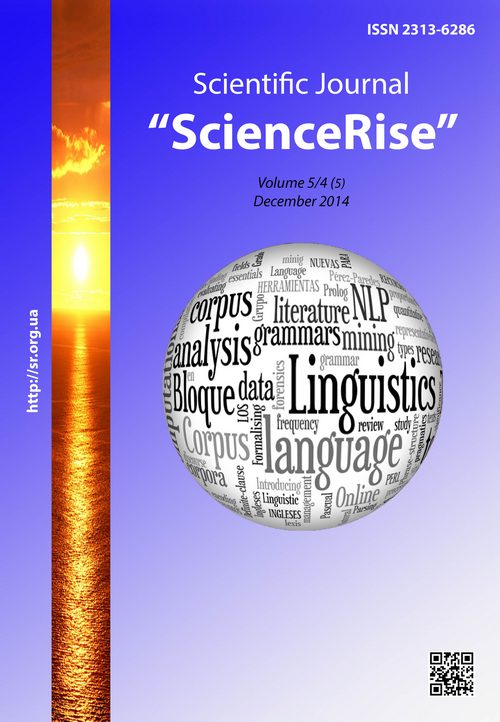Effect of modern milking technologies and psyhrotrophic microorganisms on fatty acid in milk
DOI:
https://doi.org/10.15587/2313-8416.2014.32252Keywords:
free fatty acids, milking with robotics, refrigerated storage of raw milk, psyhrotrophs, Pseudomonas sppAbstract
It was found that the milking of cows with robotics has a greater influence on formation of free fatty acids (FFA) in milk than automatic milking "Carousel." Among all researched FFA, the largest concentrations in milk were palmitic, oleic and stearic fatty acids. Pseudomonas spp in milk during refrigerated storage secrete lipase, promoting the FFA formation. Adding a solution of H2O2 to raw milk stops the formation of bacterial lipases.
References
Ipema, A. H., Schuiling, E. (1992). Free fatty acids; influence of milking frequency. in Proceedings of the Symposium Prospects for Automatic Milking EAAP Publ. 65, Wageningen, the Netherlands, 491–496.
Klungel, G. H., Slaghuis, B. A., Hogeveen, H. (2000). The effect of the introduction of automatic milking on milk quality. Journal of Dairy Science, 83 (9), 1998–2003. doi: 10.3168/jds.s0022-0302(00)75077-6
Cartier, P., Chilliard, Y. (1990). Spontaneous lipolysis in bovine milk: combined effects of nine characteristics in native milk. Journal of Dairy Science, 73 (5), 1178–1186. doi: 10.3168/jds.s0022-0302(90)78780-2
Rasmussen, M. D., Bjerring, M., Justesen, P., Jepsen, L. (2002). Milk quality on Danish farms with automatic milking systems. Journal of Dairy Science, 85 (11), 2869–2878. doi: 10.3168/jds.s0022-0302(02)74374-9
Escobar, G. J., Bradley, R. L. (1990). Effect of mechanical treatment on the free fatty acid content of raw milk. Journal of Dairy Science, 73 (8), 2054–2060. doi: 10.3168/jds.s0022-0302(90)78884-4
Antonelli, M. L., Curini, R., Scricciolo, D., Vinci, G. (2002). Determination of free fatty acids and lipase activity in milk: quality and storage markers. Talanta, 58 (3), 561–568. doi: 10.1016/s0039-9140(02)00324-7
Mikulova, M. (2011). Content of free fatty acids lipolytic bacteria and somatic cells in relation to milking technology. Journal of Agrobiology, 28 (1), 49–54. doi: 10.2478/v10146-011-0005-8
Cempirkova, R., Mikulova, M. (2009). Incidence of psychrotrophic lipolytic bacteria in cow’s raw milk. Czech J. Anim. Sci., 54 (2), 65–73.
Fleming, M. G. (1980). Mechanical factors associated with milk lipolysis in bovine milk. In IDF bulletin 118 Flavour impairment of milk and milk products due to lipolysis, 41–52.
De Koning, C. J. A. M., Slaghuis, B., van der Vorst, Y. (2004). Milk Quality on Farms with an Automatic Milking System. Proceedings of the international symposium Automatic Milking, a better understanding, Wageningen Academic Publishers, Wageningen, the Netherlands, 311–320.
Wiking, L., Bjrck, L., Nielsen, J. H. (2004). Impact of size distribution of milk fat globules on milk quality affected by pumping. Automatic Milking- a better understanding. Wageningen Academic Publishers, 348–356
Foltys, V., Kirchnerova, K. (2006). Mesophilic and psychrotrophic aerobe sporulating microorganisms in raw cow’s milk. Central European Journal of Biology, 1 (4), 545–560. doi: 10.2478/s11535-006-0037-z
Pešek, M., Samková, E., Špička, J. (2006). Fatty acids and composition of their important groups in milk fat of Czech Pied cattle. Czech J. Anim. Sci., 51, 181–188
Berentsen, P. B. M., Engel, B., De Koning, C. J. A. M., Oude Lansink, A. G. J.,M. (2010). Increasing the Revenues from Automatic Milking by Using Individual Variation in Milking Characteristics. Economical sensitivity of four main parameters defining the room for investment of AM-systems on dairy farms, Robotic Milking, Proceedings of the international symposium held in Lelystad, 201–211.
Bijl, R., Kooistra, S. R., Hogeveen, H. (2007). The Profitability of Automatic Milking on Dutch Dairy Farms. Journal of Dairy Science, 90 (1), 239–248. doi: 10.3168/jds.s0022-0302(07)72625-5
De Koning, C. J. A. M., Rodenburg, J. (2004). Automatic Milking: State of the Art in Europe and North America. Automatic milking – A better understanding, Wageningen Academic Publishers, Wageningen, the Netherlands, 27-40.
Hink, P. (2000). Effects of husbandry systems on the efficiency and optimisation of robotic milking performance and management. International Symposium on Robotic Milking, Lelystad, The Netherlands, 167–176.
Vorst, Y., Koning, K. (2002). Automatic milking systems and milk quality in three European countries. Proc. 1rst North American Conference on Robotic Milking, Toronto, Canada, V1-V12.
Vegricht, J. (2002). Study of Using Automati c Milking Systems on Large Dairy Farms. Research In Agricultural Engineering, 48 (1), 1–6.
Barth K., Fischer R., Worstorff H. (2000). Evaluation of variation in conductivity during milking to detect sub- clinical mastitis in cows milked by robotic systems. Proc. International Symposium on Robotic Milking, Lelystad, The Netherlands, 89-96.
Klungel, G. H., Slaghuis, B. A., Hogeveen, H. (2000). The effect of the introduction of automatic milking systems on milk quality. Journal of Dairy Science, 83 (9), 1998–2003. doi: 10.3168/jds.s0022-0302(00)75077-6
Hantis-Zacharov, E., Halpern, M. (2007). Culturable psychrotrophic bacteria communities in raw milk and their proteolytic and lipolytic traits. Applied and Environmental Microbiology, 73 (22), 7162–7168. doi: 10.1128/aem.00866-07
Downloads
Published
Issue
Section
License
Copyright (c) 2014 Александра Николаевна Бергилевич, Андрей Николаевич Марченко, Олег Александрович Бергилевич

This work is licensed under a Creative Commons Attribution 4.0 International License.
Our journal abides by the Creative Commons CC BY copyright rights and permissions for open access journals.
Authors, who are published in this journal, agree to the following conditions:
1. The authors reserve the right to authorship of the work and pass the first publication right of this work to the journal under the terms of a Creative Commons CC BY, which allows others to freely distribute the published research with the obligatory reference to the authors of the original work and the first publication of the work in this journal.
2. The authors have the right to conclude separate supplement agreements that relate to non-exclusive work distribution in the form in which it has been published by the journal (for example, to upload the work to the online storage of the journal or publish it as part of a monograph), provided that the reference to the first publication of the work in this journal is included.

